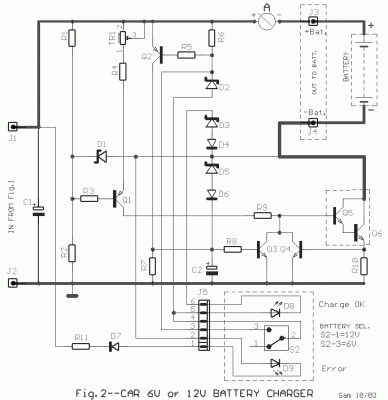- USB Powered Mobile Phone Battery Charger
- NiMh and NiCd Battery Charger Circuit
- NiCd Battery Charger With Reverse Polarity Protection
- Mobile Phone and iPod Battery Charger Circuit
- Mobile Phone Travel Charger Circuit Diagram
- Mobile Phone Battery Charger Circuit
- Mobile Cellphone Battery Charger Circuit
- Low Cost Universal Battery Charger Schematic
- Lithium-Polymer Peak Charger
- In-Car Charger And Switcher Circuit For SLA Battery
- Battery Charger Regulator
- A Friendly Charger Schematic for Mobile Phones
- 12 Volt Car Battery Charger Circuit Schematic
- Versatile Micropower Battery Protector
- Flashing-LED Battery-Status Indicator Circuit
Car Battery 6V or 12V charger
Description
Always we needed a charger with which we can charge the car battery. This circuit can charge automatically, fast and rightly, batteries 6V and 12V. A basic factor in the success in the circuit operation is the use of transformer [T1] of good quality with very good insulation and resistance in the short circuits. The Q1 via divider R1-2, the TR1 and the R4, functions as regulated current source. The current via the R9 drives the power transistors Q5 -6, where is strengthened X2000 times roughly. In a car battery charger the voltage is roughly 6V until 8V. With these conditions the charge current is roughly 1.2A [is regulated by TR1]. When the battery charge slowly, is increased her voltage in across. In the 7V it begins conduct the D1. As long as its increased the battery voltage is decreased the voltage in across the R3 making Q1 conductible. This continued as far the current reaches the 6A roughly. Then via the fall of tendency in utmost the R10, becomes driver the Q4. The current that in excess in base of Q5 grounded, confecting the current charge constant. When the battery charger [14.4V] is completely, activated the parallel to the battery circuit that is constituted by the R6, D8, and D2 until D6. Simultaneously turns on the D8 that shows that battery charged completely. Simultaneously Q2 turn on from cause of voltage fall in the R6. The Q3 becomes conductible and grounding some of current in the Q5 base. When the voltage across the battery reaches roughly in the 15V the current in the Q5 base is very small, so that stops the battery charging. Diodes D5-6 protect the circuit from error placement of battery or from short-circuit of big duration. Diode D4 protects the circuit from error placement of poles of battery. Then Led D9 turns on shows the connection ERROR. Closing switch S2 short the diode D2 [6.8V], now we can charge a battery 6V.
Adjustment
The inceptive charge current should be adjusted via the TR1 in 1.2A. Adjust can become with a battery 6V. Connect in cascade with the battery a ampere meter [biggest 10A]. If does not exist battery 6V, sorted output charger via their ampere meter and we adjust with the TR1 the current in 1.2A. At the regulation switch S2 it should they are in the 12V place, that is to say open. Attention should be given in the diodes D2 and D3 precision because these protect the battery from overcharge. If the voltage deviation is up to 100mV we believe to consider as acceptable. If you meet difficulties in the current adjustment and TR1 is not enough, you can change the resistance R4 value, until you measure charge current become 1.2A. The two parallel resistors that constitute the R10, it should they are placed in distance by printed board and Q5-6, because they are heated. Bridge B1 and Q5-6 should be placed on heatsink after isolate electric from this with suitable silicone mica. Bridge B1 and the PCB where it will be placed circuit should connected with near and fat cables, special there that the current are big. Also the lines in PCB should have proportional width [in the drawing they appear with far line]. The manufacture should become in a good metal box, suitable dimensions so that exists good ventilation. The all manufacture requires the proportional experience. The WORK WITH BATTERIES REQUIRES VERY BIG ATTENTION IN the HANDLING, BECAUSE EXIST ALWAYS the DANGER of EXPLOSION.
Circuit diagram
Part List
- R1-11=1K ohm 0.5W 5%
- R2=22K ohm 0.5W 5%
- R3-5-8=10K ohm 0.5W 5%
- R4=2.2K ohm 0.5W 5%
- R6=100 ohm 0.5W 5%
- R7=100K ohm 0.5W 5%
- R9=470 ohm 0.5W 5%
- R10=0.08 ohm 10W [2X0.18 ohm parallel] 5W
- B1=Bridge Rectifier 25A/40V
- D1-2=6.8V 0.4W Zener
- D3=4.7V 0.4W Zener
- D4-6-7=1N4148
- D5=18V 0.4W Zener
- D8=LED 5mm Yellow
- D9=LED 5mm Red
- Q1-2=BC557
- Q3-4=BC547
- Q5=BD139 [On Heatsink]
- Q6=2N3055 [On Heatsink]
- TR1=4.7K Trimmer Pot.
- C1=4700uF 40V
- C2=1uF 25V
- T1=230Vac//15V 10A Transf. [See Text]
- F1=Fuse 1A Slo Blo [5X20mm]
- S1=2X2 Switch 10A per contact
- S2=1X2 step mini switch
- J1...4=Flat Pin Connector
- J5=6pin Connector 2.54mm pin step
- A=0-10A Ampere meter
- Batt=12V or 6V Battery

